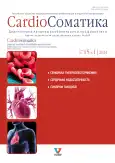Heart failure with preserved ejection fraction: A short review of diagnosis and management
- Authors: Laksono S.1,2, Prameswari P.1
-
Affiliations:
- Department of Cardiology and Vascular Medicine, Diagram Heart Hospital Siloam Cinere
- Faculty of Medicine, Universitas Muhammadiyah Prof Dr Hamka
- Issue: Vol 15, No 1 (2024)
- Pages: 71-79
- Section: Reviews
- URL: https://journals.rcsi.science/2221-7185/article/view/256939
- DOI: https://doi.org/10.17816/CS623815
- ID: 256939
Cite item
Full Text
Abstract
Around 64 million persons in the world have heart failure (HF). HF patients with left ventricle ejection fraction (LVEF) of ≥50% are classified as having HF with preserved ejection fraction (HFpEF). It is estimated that about fifty percent of all HF is HFpEF. Our aim was to provide evidence of contemporary data regarding diagnosis and management of HFpEF. We conducted literature search through online search such as Google Scholar and PubMed Central (PMC), focusing on diagnosis and management of HFpEF. Several criteria exist for the diagnosis of HFpEF, including EF >50%, evidence of diastolic dysfunction, elevated brain natriuretic peptide. High (≥15) or intermediate (9–14) E/eʹ index indicates the likelihood of HFpEF. SGLT2I decrease E/eʹ, indicating improvement of LV diastolic function as mentioned in several studies. Treatment duration to achieve this effect spans from 3 months to 1 year. SGLT2I have positive effect on echocardiographic parameter HFpEF patients. In the researches included in the review, E/eʹ was mainly used as primary end point.
Full Text
##article.viewOnOriginalSite##About the authors
Sidhi Laksono
Department of Cardiology and Vascular Medicine, Diagram Heart Hospital Siloam Cinere; Faculty of Medicine, Universitas Muhammadiyah Prof Dr Hamka
Author for correspondence.
Email: sidhilaksono@uhamka.ac.id
ORCID iD: 0000-0002-2959-8937
MD, healthcare manager
Indonesia, West Java; TangerangPrita Saskya Prameswari
Department of Cardiology and Vascular Medicine, Diagram Heart Hospital Siloam Cinere
Email: pritaprameswari@gmail.com
ORCID iD: 0009-0004-0948-6307
Indonesia, West Java
References
- Redfield MM, Borlaug BA. Heart Failure With Preserved Ejection Fraction: A Review. JAMA. 2023;329(10):827–838. doi: 10.1001/jama.2023.2020
- McDonagh TA, Metra M, Adamo M, et al. 2021 ESC Guidelines for the diagnosis and treatment of acute and chronic heart failure. Eur Heart J. 2021;42(36):3599–3726. doi: 10.1093/eurheartj/ehab368. Erratum in: Eur Heart J. 2021. Oct 14
- Mumpuni H, Adhi Kusumastuti D, Purnasidha Bagaswoto H, Yuli Setianto B. Epidemiology, Aetiology and Risk Profile of Heart Failure in a Tertiary Referral Hospital: a Report from the Sardjito Heart Failure Registry. Acta Cardiologia Indonesiana. 2020;7(1):7–12.
- Egashira K, Sueta D, Komorita T, et al. HFA-PEFF scores: prognostic value in heart failure with preserved left ventricular ejection fraction. Korean J Intern Med. 2022;37(1):96–108. doi: 10.3904/kjim.2021.272
- PERKI. Pedoman Tatalaksana Gagal Jantung. Perhimpunan Dokter Spesialis Kardiovaskular. Indonesia; 2020. P. 848–853.
- Pieske B, Tschöpe C, de Boer RA, et al. How to diagnose heart failure with preserved ejection fraction: the HFA-PEFF diagnostic algorithm: a consensus recommendation from the Heart Failure Association (HFA) of the European Society of Cardiology (ESC). Eur Heart J. 2019;40(40):3297–3317. doi: 10.1093/eurheartj/ehz641. Erratum in: Eur Heart J. 2021;42(13):1274.
- Laksono S, Hosea GT, Nurusshofa Z. Diabetic Cardiomyopathy: Pathophysiology and Novel Therapies. Brown Hospital Medicine. 2022;1(3). Available from: https://bhm.scholasticahq.com/article/37850-diabetic-cardiomyopathy-pathophysiology-and-novel-therapies. doi: 10.56305/001c.37850
- Sotomi Y, Iwakura K, Hikoso S, et al. Prognostic significance of the HFA-PEFF score in patients with heart failure with preserved ejection fraction. ESC Heart Fail. 2021;8(3):2154–2164. doi: 10.1002/ehf2.13302
- Putra MGD, Laksono S. Sodium Glucose Co-Transporter-2 (SGLT 2) Inhibitor as A Therapy For Heart Failure With Low Ejection Fraction (HFrEF). FITOFARMAKA: Jurnal Ilmiah Farmasi. 2022;12(2):148–55.
- Laksono S. Heart Failure Clinic: A Practical Guide for Health Practitioners in Hospitals. Jurnal Kesehatan Pasak Bumi Kalimantan. 2022;5(1):32–36.
- Besmaya BM, Laksono S. Mekanisme Penghambat Sodium-Glukosa Transport Protein-2 (SGLT2-i) pada Penyakit Kardiovaskular: Sebuah Tinjauan. MPI (Media Pharmaceutica Indonesiana). 2023;5(1):71–85. (In Indonesian). doi: 10.24123/mpi.v5i1.5266
- Laksono S, Syukran. Management of Heart Failure in the Hospital: A Clinical Approach. Ahmad Dahlan Medical Journal. 2023;4(2);117–132.
- Santos-Gallego CG, Requena-Ibanez JA, San Antonio R, et al. Empagliflozin Ameliorates Diastolic Dysfunction and Left Ventricular Fibrosis/Stiffness in Nondiabetic Heart Failure: A Multimodality Study. JACC Cardiovasc Imaging. 2021;14(2):393–407. doi: 10.1016/j.jcmg.2020.07.042
- Redfield MM. Heart Failure with Preserved Ejection Fraction. N Engl J Med. 2016;375(19):1868–1877. doi: 10.1056/NEJMcp1511175
- Akasaka H, Sugimoto K, Shintani A, et al. Effects of ipragliflozin on left ventricular diastolic function in patients with type 2 diabetes and heart failure with preserved ejection fraction: The EXCEED randomized controlled multicenter study. Geriatr Gerontol Int. 2022;22(4):298–304. doi: 10.1111/ggi.14363
- Sakai T, Miura S. Effects of Sodium-Glucose Cotransporter 2 Inhibitor on Vascular Endothelial and Diastolic Function in Heart Failure With Preserved Ejection Fraction — Novel Prospective Cohort Study. Circ Rep. 2019;1(7):286–295. doi: 10.1253/circrep.CR-19-0018
- Soga F, Tanaka H, Tatsumi K, et al. Impact of dapagliflozin on left ventricular diastolic function of patients with type 2 diabetic mellitus with chronic heart failure. Cardiovasc Diabetol. 2018;17(1):132. doi: 10.1186/s12933-018-0775-z
- Matsutani D, Sakamoto M, Kayama Y, et al. Effect of canagliflozin on left ventricular diastolic function in patients with type 2 diabetes. Cardiovasc Diabetol. 2018;17(1):73. doi: 10.1186/s12933-018-0717-9
- Santos-Gallego CG, Vargas-Delgado AP, Requena-Ibanez JA, et al. Randomized Trial of Empagliflozin in Nondiabetic Patients With Heart Failure and Reduced Ejection Fraction. J Am Coll Cardiol. 2021;77(3):243–255. doi: 10.1016/j.jacc.2020.11.008
- Cappetta D, De Angelis A, Ciuffreda LP, et al. Amelioration of diastolic dysfunction by dapagliflozin in a non-diabetic model involves coronary endothelium. Pharmacol Res. 2020;(157):104781. doi: 10.1016/j.phrs.2020.104781
Supplementary files







